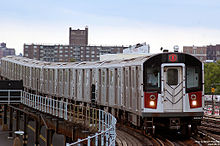New York City subway
 |
|||

Top: A 6 train made up of R142A cars enters the Parkchester station.
Bottom: An E train made up of R160A cars waits for passengers at the 42nd Street–Port Authority Bus Terminal station. |
|||
| Overview | |||
|---|---|---|---|
| Owner | City of New York | ||
| Locale | New York City | ||
| Transit type | Rapid transit | ||
| Number of lines |
36 lines 25 services (1 planned) |
||
| Number of stations |
472 (MTA total count) 425 unique stations (when compared to international standards) 1 under construction 14 planned |
||
| Daily ridership | 5,650,610 (weekdays, 2015) 3,309,731 (Saturdays, 2015) 2,663,418 (Sundays, 2015) |
||
| Annual ridership | 1,762,565,419 (2015) | ||
| Website | mta |
||
| Operation | |||
| Began operation | October 27, 1904 (first underground section) July 3, 1868 (first elevated, rapid transit operation) October 9, 1863 (first railroad operation) |
||
| Operator(s) | New York City Transit Authority (NYCTA) | ||
| Number of vehicles | 6,407 | ||
| Headway | Peak hours: 2–5 minutes Off-peak: 10–20 minutes |
||
| Technical | |||
| System length | 236 mi (380 km) (route length) 665 mi (1,070 km) (track length, revenue) 850 mi (1,370 km) (track length, total) |
||
| Track gauge | 4 ft 8 1⁄2 in (1,435 mm) standard gauge | ||
| Electrification | 600–650 V (DC) third rail; normally 625V | ||
| Average speed | 17 mph (27 km/h) | ||
| Top speed | 55 mph (89 km/h) | ||
|
|||
The New York City Subway is a rapid transit system owned by the City of New York and leased to the New York City Transit Authority, a subsidiary agency of the state-run Metropolitan Transportation Authority (MTA). Opened in 1904, the New York City Subway is one of the world's oldest public transit systems, one of the world's most used metro systems, and the metro system with the most stations. It offers service 24 hours per day, every day of the year.
The New York City Subway is the largest rapid transit system in the world by number of stations, with 472 stations in operation (425 if stations connected by transfers are counted as single stations). Stations are located throughout the boroughs of Manhattan, Brooklyn, Queens, and the Bronx. The Staten Island Railway is not officially considered part of the subway, as it lacks a rail link with the subway system, so passengers traveling to another borough take a ferry or bus; however, free transfers are allowed to the New York City Subway and the MTA's bus system. The Port Authority Trans-Hudson and the AirTrain JFK, in Manhattan and Queens respectively, accept the subway's MetroCard but are not operated by the MTA and do not allow free transfers. Another mass transit service that is not operated by the MTA, the Roosevelt Island Tramway, does allow free transfers to the MTA and bus systems, however.
...
Wikipedia

